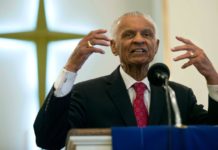I am a mother of two young children, and I wish I could say that the pain that parents in Uvalde, Texas, feel this morning is unimaginable to me. But the truth is it that although I have never experienced it directly, I have had to imagine that pain many times.
I imagined it when I arrived one day to pick up my older daughter, then not even 2 years old, from day care in Washington, D.C., and found that they were conducting an active shooter drill with the babies and toddlers.
Her teachers explained that they were training the children to hide in a small dark room and not make a sound, so that if one day the worst happened, the shooter might not realize they were there. I imagined how useless silence and a locked door would be against someone who had set out to murder young children. I imagined the life-destroying grief that would follow.
By then I already had practice at the imagining. A few years earlier, when my husband, then a teacher in a public school, texted me that they were locked down because of a reported shooting in the building, I imagined him being killed, or being helpless to save his students. I imagined our life together shattering.
And just as thousands of children in America are doubtless doing today, I had imagined that pain when I was still a child myself. After the Columbine massacre, my classmates and I talked about the fact that our tall urban school building had only two staircases, two main exits, and how that meant a mass murderer would just have to pull a fire alarm and then wait at the door for half of the school to be ushered into the sight of his gun. Though I kept up a shallow teenage bravado during the conversation, I imagined my sister and I going to different exits. I imagined only one of us making it out.
In all of those instances, the disaster I imagined never came to pass. I was more fortunate than the families in Uvalde, in Sandy Hook, or in Parkland.
But there is still a cost to living in a country where children are taught that school is a place where they might be trapped and murdered; to living in a country where being a schoolteacher means making a Secret Service-style commitment to hurl oneself in front of a speeding bullet. The imagining, the fear, is a cost in and of itself.
I don’t live in the United States right now. Today my older daughter goes to a primary school that does not have any active-shooter drills, and is not learning that her school is a place where she needs to fear being killed. My younger daughter’s day care never taught her to hide silently in a dark room so that a shooter would not find her. They do not have to wonder if their school will be the next one after Uvalde. I do not have to soothe the fear that would bring. They get a little more innocence as children. I get a little more peace as their mom.
That is a benefit that most Americans cannot access, because of choices that American governments have made.
Other countries, as many, many articles will doubtlessly point out this week, have made different choices.
After the Dunblane Massacre in Scotland in 1996, in which a gunman killed 16 primary-school pupils and a teacher, the British government banned handguns. After the Port Arthur Massacre in Australia that same year, the Australian government introduced stringent gun laws, including a ban on most semiautomatic and automatic weapons as well as licensing and purchasing restrictions. After the Utoya massacre in Norway in 2011, the government banned semiautomatic firearms, persevering with the legislation despite years of opposition from a well-organized hunters’ lobby. After the Christchurch shootings in 2019, New Zealand’s government passed stringent new restrictions on gun ownership and announced a buyback program.
Fatal American exceptionalism
The United States is different. Recent years have brought many mass shootings, including those of schoolchildren in Newtown, Connecticut and Parkland, Florida, but essentially no new gun control legislation. And like so many other things about modern American politics, the reasons are rooted in the political backlash to the civil rights movement of the 1960s, and particularly to desegregation.
“The modern quest for gun control and the gun rights movement it triggered were born in the shadow of Brown (v. Board of Education of Topeka, the landmark Supreme Court ruling in 1954),” Reva Siegel, a constitutional scholar at Yale Law School, wrote in a 2008 article in the Harvard Law Review. “Directly and indirectly, conflicts over civil rights have shaped modern understandings of the Second Amendment.”
Desegregation sparked a reactionary backlash among white voters, particularly in the south, who saw it as overreach by the Supreme Court and federal government. That backlash, with the help of conservative political strategists, coalesced into a multi-issue political movement. Promises to protect the traditional family from the perceived threat of feminism drew in white women. And influential conservative lawyers framed the Second Amendment as a source of individual “counterrights” that conservatives could seek protection for in the courts — a counterbalance to progressive groups’ litigation on segregation and other issues.
That turned gun control into a highly salient political issue for American conservatives in a way that sets the United States apart from other wealthy nations. The gun control laws in the United Kingdom, Australia and Norway were all passed by conservative governments. Although they faced some opposition to the new measures, particularly from hunters’ groups, it did not line up with a broader political movement the way gun rights did in the United States.
In the United States, by contrast, the issue is so salient, and so partisan, that embracing gun rights is practically a requirement for Republican politicians trying to prove their conservative bona fides to voters. Taking an extreme pro-gun position can be a way for candidates to stand out in crowded primary fields. Supporting gun control, by contrast, would make a Republican vulnerable to a primary challenge from the right, which helps explain why they so rarely take that position.
And even if that political landscape were to shift, there would still be the matter of the courts. As the right took up the issue of gun rights in politics, conservative lawyers gave the Second Amendment new attention in law reviews and courtrooms, Adam Winkler, a constitutional law scholar at U.C.L.A., wrote in the book “Gunfight: the Battle over the Right to Bear Arms in America.”
The Federalist Society pushed for nominations of conservative judges, slowly reshaping the judicial branch into a conservative institution that enshrined a broad Second Amendment right for individuals to own guns. Unless Supreme Court precedents like District of Columbia v. Heller get overturned, it would be difficult for the government to enact broad gun control measures.
Shootings like the one in Texas last night are enough to draw attention to the power and momentum of the pro-gun movement. But changing it would be the work of decades. Even if politicians work diligently, there will be more mass shootings before that happens. In the meantime, parents and children across the United States will imagine the pain that families in Texas are feeling today, and wonder if they might be next.
Source : Nytimes












